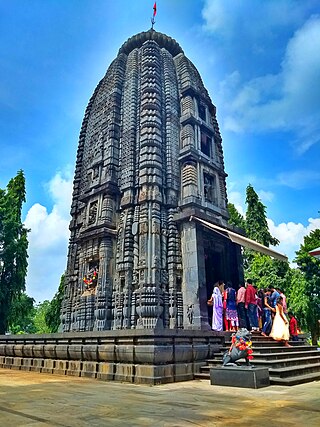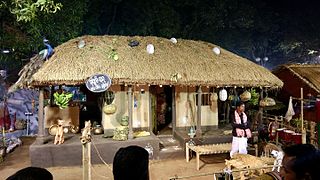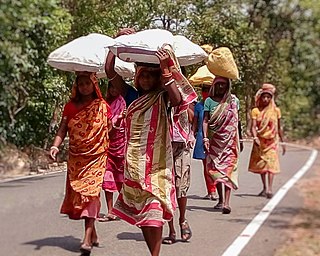Related Research Articles

Odisha, formerly Orissa, is an Indian state located in Eastern India. It is the eighth-largest state by area, and the eleventh-largest by population, with over 41 million inhabitants. The state also has the third-largest population of Scheduled Tribes in India. It neighbours the states of Jharkhand and West Bengal to the north, Chhattisgarh to the west, and Andhra Pradesh to the south. Odisha has a coastline of 485 kilometres (301 mi) along the Bay of Bengal in the Indian Ocean. The region is also known as Utkaḷa and is mentioned by this name in India's national anthem, Jana Gana Mana. The language of Odisha is Odia, which is one of the Classical languages of India.

Odia is an Indo-Aryan classical language spoken in the Indian state of Odisha. It is the official language in Odisha, where native speakers make up 82% of the population, and it is also spoken in parts of West Bengal, Jharkhand, Andhra Pradesh and Chhattisgarh. Odia is one of the many official languages of India; it is the official language of Odisha and the second official language of Jharkhand.

Baripada is a city and a municipality in Mayurbhanj district in the state of Odisha, India. Located along the east bank of the Budhabalanga river, Baripada is the cultural centre of north Odisha. In recent years, it has emerged as an educational hub with the opening of numerous professional colleges.

Mayurbhanj district is one of the 30 districts in the Odisha state of eastern India. It holds the distinction of being the largest district in Odisha by area. The district's headquarters is located in Baripada, with other major towns including Rairangpur, Karanjia, and Bahalda. As of 2011, Mayurbhanj ranks as the third-most populous district in Odisha, following Ganjam and Cuttack.

Puri district is a coastal district of the Odisha state of India. It has one sub-division, 11 tahasils and 11 blocks and comprises 1722 revenue villages. Puri is the only municipality of the district. Konark, Pipili, Satyabadi, Gop, Kakatpur and Nimapada are the NACs in this district while Brahmagiri being a semi-urban town.

The Odia (ଓଡ଼ିଆ), formerly spelled Oriya, are an Indo-Aryan ethnic group native to the Indian state of Odisha who speak the Odia language. They constitute a majority in the eastern coastal state, with significant minority populations existing in the neighboring states of Andhra Pradesh, Chhattisgarh, Jharkhand and West Bengal.

Kendujhar District, is an administrative district of Odisha. The district is one of the fifth Scheduled Areas of Odisha. The town of Kendujhar is the district headquarters. The district has three sub-divisions, Anandapur, Champua, and Kendujhar.
Odisha is one of the 28 states of India, located on the eastern coast. It is surrounded by the states of West Bengal to the northeast, Jharkhand to the north, Chhattisgarh to the west and northwest, and Andhra Pradesh to the south and southwest. Odia is the official and most widely spoken language, spoken by 33.2 million according to the 2001 Census. The modern state of Odisha was established on 1 April 1936, as a province in British India, and consisted predominantly of Odia-speaking regions. April 1 is celebrated as Odisha Day.

Bagata people are one of the tribal ethnic groups of India, mainly concentrated in Andhrapradesh and Odisha. As per the Indian constitution, they are designated as Scheduled Tribe for affirmative action.

Followers of Christianity are a significant minority in Odisha state of India. According to the 2011 Census, Christians make up about 2.77% of the population. Kurukh, Sora, Kharia and Panos are notable ethnic groups with a significant Christian population.

The Bhanja dynasty is a dynasty that originated in the northern and central regions of modern Odisha before the Gupta Empire became an imperial power. The dynasty, of ancient local Kshatriya lineage as documented by Hermann Kulke, succeeded the Vindhyatabi branch of the Nagas of Padmavati, who ruled from the Keonjhar district of Odisha and included Satrubhanja of the Asanpat inscription. The Bhanj later became feudatories of the Bhauma-Kara dynasty.

Shesha Shrabana is a 1976 Odia language Indian movie. It is directed by Prashant Nanda. It stars Prashant Nanda, Mahasweta Roy, Banaja Mohanty and Hemant Das. It is based on a novel of Basant Mahapatra by the same name. In 1979, the film remade as Naiyya in Hindi language by the same director. This film achieved great success in terms of box office and acclaimed by reviewers.
Chasa is a caste in India natively residing in the Indian state of Odisha. Chasas were traditionally cultivators but are now engaged in several professions. The Odia word chasa means farmer. They are third largest caste by population in Odisha.
The Pano are a Scheduled caste community of Odisha, as well as in Bihar, West Bengal and Jharkhand officially. They speak Odia language.

The Bathudi or Bathuri is a community found mainly in the north western part of Odisha. Some Bathudis, however migrated to neighbouring states of Jharkhand and West Bengal. The 2011 census showed their population to be around 220,859. They are classified as a Scheduled Tribe by the Indian government.

Bagal is a cattle herding caste of East India. Bagal people are living in the state of West Bengal, Jharkhand and Odisha. They use Kudmali/ Manbhumi dialect of Bengali as their mother tongue and use Bengali, Hindi and Odia language to communicate with the outside society.
Gajapati Rāmachandra Deva I was the founder of the Bhoi dynasty of Khurda in Odisha, India. He became the ruler of Khurda kingdom after defeating Mukunda Deva in 1568. He claimed descent from the Yaduvanshi dynasty which features prominenetly in the Indian epic, Mahabharata. The Odia populace gave him the title of "Thakura Raja" as a mark of respect for renovating the damaged Hindu temples that were destroyed by the invasion of Kalapahad. He was titled as Vira Sri Gajapati Viradhi Viravara Pratapi Ramachandra Deva.
Rajwars or Rajuar is a shifting cultivation community. The people of this community mainly live in Bihar, Jharkhand, Madhya Pradesh, Odisha and West Bengal. In Odisha, they are recognized as a Scheduled Tribe, while in Bihar, Jharkhand, and West Bengal, they are classified as Scheduled Caste. In other states, the community is considered part of the Other Backward Classes (OBC) or general population.
References
- 1 2 3 "A-11 Appendix: District wise scheduled tribe population (Appendix), Odisha - 2011". www.censusindia.gov.in. Office of the Registrar General & Census Commissioner, India. Retrieved 26 October 2023.
- 1 2 3 4 SCSTRTI, SCSTRTI. "Sounti". Home. Archived from the original on 2019-07-16. Retrieved 2019-07-16.
- ↑ Orissa (India); Senapati, N.; Sahu, N.K. (1966). Orissa district gazetteers. Gazetteer of India (in Italian). Printed by the Superintendent, Orissa Govt. Press. Retrieved 2019-07-15.
- 1 2 Laeequddin, Muhammad (1937). Census of Mayurbhanj State 1931. Vol. I. Calcutta: Caledonin Printing Company. pp. 196–197. JSTOR saoa.crl.25352830 . OCLC 496724918. Archived from the original on 17 January 2017.
- ↑ Singh, K. S. (1996). Communities, Segments, Synonyms, Surnames and Titles. Anthropological Survey of India. ISBN 978-0-19-563357-3.
- ↑ "Archived copy" (PDF). Archived (PDF) from the original on 2018-11-05. Retrieved 2019-07-16.
{{cite web}}: CS1 maint: archived copy as title (link) - ↑ Pati, R.N.; Dash, J. (2002). Tribal and Indigenous People of India: Problems and Prospects. A.P.H. Publishing Corporation. p. 62. ISBN 978-81-7648-322-3 . Retrieved 2019-07-14.
- ↑ India, S.I. (2014). State of the Adivasis in Odisha 2014: A Human Development Analysis. SAGE Impact. SAGE Publications. p. 94. ISBN 978-93-5150-049-0 . Retrieved 2019-07-16.